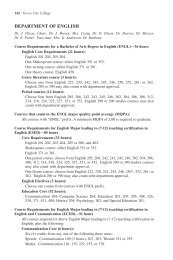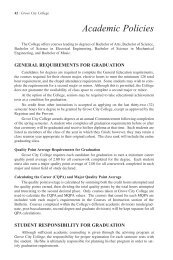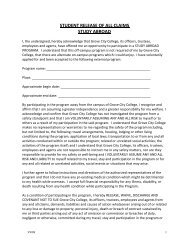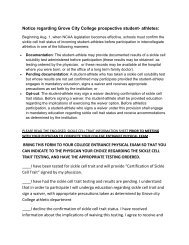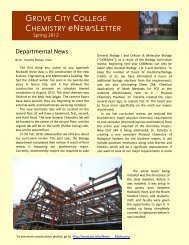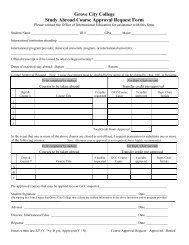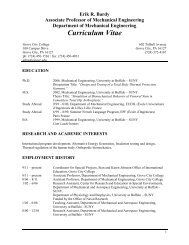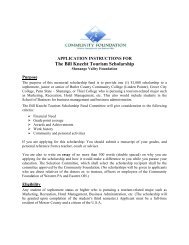A Review of Power-Generating Turbomachines - Grove City College
A Review of Power-Generating Turbomachines - Grove City College
A Review of Power-Generating Turbomachines - Grove City College
Create successful ePaper yourself
Turn your PDF publications into a flip-book with our unique Google optimized e-Paper software.
A <strong>Review</strong> <strong>of</strong> <strong>Power</strong>-<strong>Generating</strong> <strong>Turbomachines</strong><br />
Joel Bretheim and Erik Bardy<br />
<strong>Grove</strong> <strong>City</strong> <strong>College</strong>, <strong>Grove</strong> <strong>City</strong>, Pennsylvania 16127<br />
Email: BretheimJU1@gcc.edu, ERBardy@gcc.edu<br />
Abstract<br />
A turbomachine is a device which interacts with a continuously flowing fluid by means <strong>of</strong> a<br />
rotor, which results in either the extraction <strong>of</strong> energy from the fluid (as in turbines), or the<br />
addition <strong>of</strong> energy to the fluid (as in compressors and pumps). Two major applications <strong>of</strong><br />
turbomachinery include power generation and propulsion. This paper presents an overview <strong>of</strong><br />
current and past developments <strong>of</strong> turbomachinery in power generation, as well as a review on<br />
research involved in future developments. Specifically, turbines in the steam, gas combustion,<br />
hydroelectric, ocean energy, and wind sectors are examined. In addition, a brief description <strong>of</strong><br />
the historical development <strong>of</strong> these various turbine types is included, as well as a discussion <strong>of</strong><br />
their current designs, with an emphasis on the rotor.<br />
Current research topics related to steam turbines include computer modeling <strong>of</strong> two-phase flow<br />
fields to reduce erosion in the machines, as well as the use <strong>of</strong> unsteady computational fluid<br />
dynamics (CFD) packages to assess blade design with respect to aeroelastic instability, with the<br />
goal <strong>of</strong> improving component lifespan and efficiency. In gas combustion turbines, current efforts<br />
in sustainability are focused on identifying alternative fuels and reducing emissions, as dictated<br />
by ever stricter environmental regulations. Hydraulic turbines employed in hydroelectric power<br />
plants are subject to cavitation and its destructive effects. Researchers are using new CFD<br />
analysis techniques to handle, reduce, or avoid cavitation in the flow <strong>of</strong> hydraulic turbines,<br />
leading to better performance, efficiency, and cost-savings. On the ocean energy front (a largely<br />
undeveloped but very promising source <strong>of</strong> renewable energy), researchers are adapting blade<br />
element momentum theory (BEMT) performance models and the Reynolds-Averaged Navier<br />
Stokes (RANS) equations to tidal turbine systems analysis and wave turbine systems with the<br />
goal <strong>of</strong> increasing cost-competitiveness <strong>of</strong> ocean energy. Finally, the wind sector is addressed<br />
with a discussion <strong>of</strong> current research in <strong>of</strong>fshore wind turbines and wind turbine farm array<br />
optimization.<br />
The future development and research portion <strong>of</strong> the discussion is presented with an underlying<br />
emphasis on efficiency, sustainability, and cost-savings.<br />
Introduction<br />
This paper presents electrical-power generating turbines by flow-type; first compressible-flow<br />
type turbines are examined in sections 1 and 2, followed by incompressible-flow type turbines in<br />
sections 3 and 4, and then wind turbines in section 5. Each section addresses the historical<br />
development, current usage and rotor design, as well as the status <strong>of</strong> current and future research<br />
and development for each turbine type. The greatest research discussion is found in the sections<br />
covering ocean and wind energy. These two energy sectors are in a state <strong>of</strong> growth now that<br />
steam, gas, and hydraulic turbines are not, as they are older and more established technologies.<br />
Proceedings <strong>of</strong> the 2012 ASEE North Central Section Conference<br />
Copyright © 2012, American Society for Engineering Education<br />
1
1.0 Steam Turbines<br />
1.1 Past<br />
The idea <strong>of</strong> using steam to produce work has been around for centuries, dating back to the time<br />
<strong>of</strong> Archimedes. It was not until the industrial revolution, however, that steam power started to<br />
realize its potential in the form <strong>of</strong> reciprocating engines and turbines. The first impulse type<br />
turbine was created by Carl Gustaf de Laval in 1883. This was closely followed by the first<br />
practical reaction type turbine in 1884, built by Charles Parsons. Parsons’ first design was a<br />
multi-stage axial-flow unit, which Westinghouse acquired and began manufacturing in 1895,<br />
while General Electric acquired de Laval’s designs in 1897. Since then, development has skyrocketed<br />
from Parsons’ early design, producing 0.746 kW, to modern nuclear steam turbines<br />
producing upwards <strong>of</strong> 1500 MW. 1 Today, steam turbines account for roughly 90% <strong>of</strong> electrical<br />
power generated in the United States. 2<br />
1.2 Current Design<br />
Steam turbines can be designed for either radial- or axial-flow. Modern steam turbines are<br />
predominantly axial-flow units, especially in large power plant applications. Steam and gas<br />
turbines are both used extensively in power plants to drive electric generators, but steam turbines<br />
are generally much larger in size. The rotors are generally multistage arrangements designed to<br />
handle high pressures in the first stages and lower pressures in the later stages. 3<br />
The two major axial-flow turbine stage configurations are impulse and reaction. The distinction<br />
is based upon relative pressure drop across the stage, where one stage consists <strong>of</strong> one row <strong>of</strong><br />
stationary blades/nozzles, and one row <strong>of</strong> rotating blades. A design is considered an impulse<br />
design if most or the entire pressure drop occurs across the stationary blade or nozzle (a 0%<br />
reaction). A reaction design experiences a pressure drop across both the stationary and rotating<br />
blades. If the pressure drop is split equally between the stationary and rotating blades, the<br />
reaction is 50%. 1 As the steam flows across a stage its kinetic energy does work upon the<br />
rotating blades. One tool important to the understanding <strong>of</strong> energy transfer from steam to rotor is<br />
the velocity triangle.<br />
Figure 1: a) Typical steam turbine stage 1 b) Velocity triangle for a reaction turbine c) Velocity<br />
triangle for an impulse turbine. 3<br />
In the impulse turbine design, the magnitude <strong>of</strong> the relative velocity <strong>of</strong> the steam remains<br />
unchanged (W2 = W3), but the absolute velocity exiting the rotor is greatly reduced (V3
difference in the squares <strong>of</strong> the velocities V2 and V3. The reaction design velocity triangle differs<br />
from the impulse design in that W3 is much larger than W2. This increase in relative velocity<br />
corresponds to a pressure drop across the rotating blades and a loss <strong>of</strong> enthalpy. A multistage<br />
turbine can be designed to have each nozzle row coupled with one moving blade row (pressure<br />
compounding), or have one nozzle row direct steam to multiple moving blade rows (velocity<br />
compounding). There are also intermediary designs that incorporate both pressure and velocity<br />
compounding.<br />
1.3 Future Developments and Research<br />
Recent developments and improvements in three-dimensional Computational Fluid Dynamics<br />
(CFD) codes have allowed researchers to gain new insight into steam turbine problems.<br />
Reliability is <strong>of</strong> critical importance in steam power generation 1 , and so current research<br />
surrounding steam turbines is focused around a few fundamental areas, in particular, multiphase<br />
flow and aeroelastics. Two-phase flow in steam turbines poses a significant problem for turbine<br />
component lifespan and reliability due to water erosion, particularly in the final stages.<br />
Researchers are using three-dimensional numerical simulation to study two-phase flow fields to<br />
learn how to minimize water erosion. 4,5,6 Blade flutter due to aeroelastic instability is another<br />
significant concern in turbine reliability. These vibrations occur due to tip shrouds on the last<br />
stage moving blades during high mass flow, which are necessary for performance reasons.<br />
Researchers are using unsteady CFD packages to assess blade design and identify aeroelastic<br />
stability margins for safe operation. 7 Steam turbine design will continue to change as CFD<br />
packages become more advanced and researchers put them to use.<br />
2.0 Gas Combustion Turbines<br />
2.1 Past<br />
Steam turbines developed first around the time <strong>of</strong> the industrial revolution. It was not until the<br />
1930s and 1940s that gas turbines began to be developed and utilized as aircraft engines. The<br />
1960s saw the advent <strong>of</strong> gas turbines for power generation applications, particularly in peaking<br />
power plants and co-generation plants (as supplements to the more conventional steam turbine<br />
plants). Gas turbine technology increased rapidly to a unit size <strong>of</strong> 100 MW within 30 years.<br />
Modern gas turbines generate upwards <strong>of</strong> 300 MW. 8<br />
2.2 Current Design<br />
Gas combustion turbines are similar to steam turbines in that they are generally axial-flow<br />
designs. Radial-flow gas turbines are considered simpler, and there are some applications for it,<br />
but axial-flow designs are preeminent in aircraft and stationary power plants. The basic gas<br />
turbine is comprised <strong>of</strong> three major components: a centrifugal<br />
or axial-flow compressor (to compress the working gas from a<br />
state <strong>of</strong> low pressure to high pressure), the combustor or heat<br />
exchanger (to raise the exit gas-fuel mix temperature), and the<br />
turbine itself (to extract energy from the working gas,<br />
producing mechanical power). The compressor and turbine<br />
are generally interdependent, operating <strong>of</strong>f the same shaft. 9<br />
Proceedings <strong>of</strong> the 2012 ASEE North Central Section Conference<br />
Copyright © 2012, American Society for Engineering Education<br />
Figure 2: Simple gas turbine system. 43<br />
Like steam turbines, gas turbines find extensive use in power plants but are typically much<br />
smaller in size. What really differentiates gas turbine combustion engines, and indeed where they<br />
3
have made their greatest impact, is their application to aircraft propulsion. In aircraft gas<br />
turbines, which are designed for efficiency as well as diameter and weight, a more sophisticated<br />
design includes the following components: compressor (centrifugal or axial), fans, combustors,<br />
turbine (radial or axial), ducts, air systems, nozzle guide vanes (NGVs), mixers, afterburners, and<br />
heat exchangers. 9 Typical configurations include shaft-powered (turboprops and turboshafts,<br />
used for fixed-wing and rotary-wing aircraft, respectively) and thrust-propelled (turbojets,<br />
turb<strong>of</strong>ans, and ramjets). Typical gas turbine design is similar to that <strong>of</strong> a steam turbine, with one<br />
stage being comprised <strong>of</strong> a row <strong>of</strong> nozzle guide vanes, and a corresponding row <strong>of</strong> rotor blades<br />
mounted on a rotor disc connected to the main shaft.<br />
2.3 Future Developments and Research<br />
Aside from improving efficiency, critical areas <strong>of</strong> research are fuel availability, fuel flexibility,<br />
and emissions reduction. There is presently significant research being done on combustion<br />
characteristics <strong>of</strong> alternative fuels such as ethanol 10 , palm methyl ester (PME) 11 , dimethyl ester<br />
(DME) 12 , hydrogen/syngas 13,14 , and bi<strong>of</strong>uels. 15 Researchers are using 3D CFD codes to simulate<br />
alternative fuel combustion flows and flame propagation within turbines and to analyze the fluid<br />
dynamic effects. 13,16<br />
In addition to fuel research, researchers are turning<br />
their attention more and more to emissions<br />
reduction as tighter governmental regulations<br />
necessitate. 17 As turbine efficiency has increased<br />
with increasing turbine inlet temperatures, so too<br />
has NOx production which tends to increase with<br />
inlet temperature. New engine and combustor<br />
configurations are being investigated to address<br />
these effects.<br />
Another key advancement to the future <strong>of</strong> turbine<br />
technology is turbine cooling <strong>of</strong> components in gas<br />
turbine engines to achieve higher turbine inlet<br />
temperatures. 1 Increased inlet temperatures lead to<br />
better performance and lifespan <strong>of</strong> the turbine. The thermodynamic ideal inlet temperature is<br />
around 2000 °C, but even the most advanced metal alloys cannot operate above 980 °C; hence<br />
the need for advanced cooling systems. Multiple-use alternative jet fuels are being researched<br />
and developed to achieve the desired combustion efficiency, combustion stability, emission<br />
levels, and even cooling properties. 18<br />
Figure 3: Axial turbine configuration. 9<br />
3.0 Hydroelectric/Hydraulic Turbines<br />
3.1 Past<br />
Energy has been extracted from flowing rivers and waterfalls for centuries, typically in the form<br />
<strong>of</strong> rotating waterwheels. Today hydroelectric power stations use reservoirs to control and direct<br />
flow over massive hydraulic turbines to produce electrical power on a grand scale. Very large<br />
unit sizes exceeding 800 MW in capacity have been attained, along with efficiencies upwards <strong>of</strong><br />
95%. 19 In 2007 approximately 36% <strong>of</strong> all renewable energy generated in the US came from<br />
Proceedings <strong>of</strong> the 2012 ASEE North Central Section Conference<br />
Copyright © 2012, American Society for Engineering Education<br />
4
hydroelectric power plants (about six times the amount generated by wind and solar power plants<br />
combined). 20<br />
3.2 Current Design<br />
Rotor type and size is largely dependent on the specific speed (a variable resulting from the<br />
combination <strong>of</strong> the head and power coefficients). Axial-flow turbines are best suited for high<br />
specific speeds (2.0-5.0 for Kaplan turbines) where large flow areas are desired. They typically<br />
operate at low heads with high flow rates. Radial-flow turbines are more suited for low specific<br />
speed conditions (0.3-2.0 for Francis turbines) and typically operate at high heads with low flow<br />
rates. The Pelton wheel is suited for the highest head applications with very small specific speed<br />
in the range <strong>of</strong> 0.03 to 0.3. 44<br />
Figure 4: Impeller shape changes from radial to mixed to axial with increasing specific speed. 44<br />
Specific speed plays an important role in determining rotor geometry. As illustrated by Fig. 4,<br />
the impeller shape changes as a function <strong>of</strong> specific speed. Also crucial to the rotor geometry is<br />
the pressure drop seen by the fluid. The pressure drop is the distinguishing factor between two<br />
main types <strong>of</strong> hydraulic turbine: the impulse and reaction turbine.<br />
Impulse turbines, such as the Pelton wheel, are typically employed in situations where a large<br />
potential energy is available. The potential energy is converted into kinetic energy as it flows<br />
through large pipes (penstock) and finally through nozzles before impinging on the vanes or<br />
buckets <strong>of</strong> the rotor. The force <strong>of</strong> the fluid impingement on the vanes/buckets creates a torque on<br />
the shaft. Thus, all <strong>of</strong> the energy transfer between the fluid and the rotor occurs through impulse<br />
action. The entire pressure drop occurs in the nozzles, resulting in no pressure drop as the fluid<br />
flows through the rotor. The rotor, which is composed <strong>of</strong> multiple ellipsoidal or hemispherical<br />
buckets positioned along the circumference, is not enclosed and remains at atmospheric pressure<br />
throughout the whole process. 44<br />
Figure 5: Velocity triangle comparison for the a) Pelton wheel b) Francis turbine and c) Kaplan turbine where V1 is the<br />
absolute velocity <strong>of</strong> the fluid, U is the vane speed, and W1 is the relative velocity. 3<br />
What distinguishes a reaction turbine from an impulse turbine is that a significant pressure drop<br />
occurs across the rotor. In a reaction turbine, the rotor is enclosed and completely filled with the<br />
working fluid (i.e. water). The water maintains significant kinetic energy and pressure after<br />
passing through the rotor. The direction <strong>of</strong> water flow through in the runner determines the kind<br />
<strong>of</strong> turbine. Francis turbines have water flow in the radial direction, while Kaplan turbines have<br />
water flow in the axial direction.<br />
Proceedings <strong>of</strong> the 2012 ASEE North Central Section Conference<br />
Copyright © 2012, American Society for Engineering Education<br />
5
In Francis designs the water flows through the penstock into a spiral casing and is directed by a<br />
set <strong>of</strong> guide vanes on to the turbine rotor, called a runner. After flowing through the runner, the<br />
water is discharged into the draft tube. Runner design is determined by certain key variables such<br />
as operating head, required runner speed, speed ratio (blade velocity over fluid velocity), and<br />
required runner output. In the Kaplan turbine, which is an axial-flow design best suited for high<br />
flow rates, water is directed by stay vanes through wicket gates over a propeller turbine. The<br />
propeller typically has five to eight blades. After passing through the blades, the water is<br />
discharged through a draft tube. 44<br />
Figure 6: Voith Hydro schematics <strong>of</strong> the Pelton, Francis, and Kaplan hydraulic turbines (www.voithhydro.de).<br />
3.3 Future Developments and Research<br />
A very important factor in research and development <strong>of</strong> hydraulic turbines is the handling,<br />
reduction, or avoidance <strong>of</strong> cavitation in the flow, which results in decreased power output and<br />
efficiency. Cavitation can also result in unwanted noise and vibration and contributes to gradual<br />
erosive wear <strong>of</strong> the machinery, or even sudden catastrophic failure. 19<br />
Key to research efforts is the application <strong>of</strong> computational fluid dynamics (CFD), which began<br />
about 30 years ago. CFD analysis has progressed in stages from 3D Euler solutions, to steady<br />
RANS simulations using finite volume methods, to the present state <strong>of</strong> solving unsteady RANS<br />
equations with advanced turbulence models. 21 Now these tools are being developed to<br />
incorporate two-phase flows, as in cavitation and free surface flow in Pelton turbines, the flow<br />
simulation <strong>of</strong> which is considered “by far the most complex and difficult <strong>of</strong> all hydraulic<br />
turbomachinery simulations”. 22<br />
Research is also prevalent on reaction turbines, which are generally considered more prone to<br />
cavitation than impulse turbines. Researchers have applied these tools to the analysis and flow<br />
simulation <strong>of</strong> Francis turbines with promising results that are beginning to converge and accord<br />
with the experimental data. 23 Researchers are also carrying out investigations on the acoustical<br />
properties <strong>of</strong> cavitation in order to develop equipment monitoring systems that will accurately<br />
estimate erosion level in the turbine. 24<br />
4.0 Ocean Energy Turbines (Tidal and Wave)<br />
4.1 Past<br />
The oceans <strong>of</strong> the earth represent an attractive alternative energy source. This source is<br />
nonpolluting, more predictable than wind and solar, and vastly abundant. In fact, “The projected<br />
available ocean power far exceeds the ultimate energy consumption <strong>of</strong> mankind”. 25 Worldwide<br />
Proceedings <strong>of</strong> the 2012 ASEE North Central Section Conference<br />
Copyright © 2012, American Society for Engineering Education<br />
6
esearch and development, however, is relatively limited and lags far behind research into other<br />
alternative energy resources.<br />
The ocean stores energy for potential conversion into electricity in two primary ways: thermal<br />
and mechanical. Thermal energy is available due to the temperature gradient from the surface <strong>of</strong><br />
the ocean to its depths. Solar irradiation incident on the ocean’s surface can lead to a temperature<br />
gradient <strong>of</strong> 20 °C or more between the surface and depths <strong>of</strong> about 1000 meters in the equatorial<br />
regions <strong>of</strong> the world’s oceans. Ocean Thermal Energy Conversion (OTEC) systems make use <strong>of</strong><br />
this temperature stratification as a heat engine to power the same kind <strong>of</strong> low-pressure steam<br />
turbines discussed in section 1.2. While there has been promising research in OTEC systems<br />
worldwide and especially in the U.S. since the 1960s onward, there are presently too many<br />
challenges for OTEC systems to overcome to be economically feasible in the short-term, and the<br />
U.S. Department <strong>of</strong> Energy no longer supports such research. 20<br />
In the short-term, there is more potential on the mechanical side <strong>of</strong> ocean energy for future<br />
development in electricity-producing turbine systems. The ocean stores tremendous mechanical<br />
energy in the forms <strong>of</strong> waves and tidal action, and both wave and tidal energy harnessing<br />
systems have demonstrated economic feasibility for electricity production. 20 The first tidal power<br />
station was built in the 1960s on the estuary <strong>of</strong> the Rance River, <strong>of</strong>f the northwestern coast <strong>of</strong><br />
France. The station, with an installed capacity <strong>of</strong> 240 MW, has operated very successfully and<br />
reliably for years and yet remained the only industrial-scale tidal power station until the recent<br />
completion <strong>of</strong> the Sihwa Lake tidal power station in South Korea. There are presently tidal<br />
power installations in France, Russia, China, South Korea, and Canada. Wave energy systems<br />
are even less developed than tidal systems. 25<br />
4.2 Current Design<br />
Tidal energy is typically harnessed to produce electricity in one <strong>of</strong> two ways: in-stream tidal<br />
turbines and tidal barriers/dams. 25 In-stream tidal turbines, which are relatively new technology,<br />
are typically designed as large impellors housed in a shroud or duct. Newer designs, such as<br />
those developed by Alstom/Clean Current (www.cleancurrent.com) and Irish company<br />
OpenHydro (www.openhydro.com) feature open-center shaftless impellors, which increase both<br />
performance and reliability. British company Marine Current Turbines<br />
(www.marineturbines.com) has taken another approach, developing an in-stream tidal turbine<br />
system that features multiple counter-rotating axial-flow pitch-controlled propeller rotors, similar<br />
to those currently used in the wind industry. Other companies such as UEK Corporation in the<br />
U.S. and Rotech in Scotland are developing their own unique approaches to harnessing tidal<br />
stream energy via turbines.<br />
Proceedings <strong>of</strong> the 2012 ASEE North Central Section Conference<br />
Copyright © 2012, American Society for Engineering Education<br />
7
Figure 7: a) Open-center in-stream tidal turbine developed by OpenHydro (www.openhydro.com) b) in-<br />
stream tidal turbine propeller rotor manufactured by Marine Current Turbines (www.marineturbines.com).<br />
While in-stream tidal turbine systems use relatively new turbine rotor technology, tidal<br />
barriers/dams can utilize conventional hydroelectric turbines. Specifically, the same kind <strong>of</strong> lowhead<br />
axial-flow turbines discussed in section 3. In tidal barrier/dam systems, water is collected<br />
and stored in a reservoir at high tide, and then released through turbines at low tide. The<br />
reservoir is created by a dam-like structure called a barrage and built in an estuary. Tidal<br />
systems can also be designed with more complex two-way hydroelectric turbines that generate<br />
electricity during both the reservoir charging and discharging stages. These setups rely on a<br />
natural resonant inshore frequency for successful operation. Hence, the inshore geological<br />
features are critically important. One downside is that power generation depends on the lunar<br />
cycle, causing power generation to occur at different times on different days, and therefore not<br />
always at the time <strong>of</strong> peak demand. 20<br />
Wave energy is less developed than tidal energy, but shows potential. While tidal systems can<br />
utilize relatively conventional hydroelectric turbines, there are many different concepts for<br />
mechanisms to extract energy from ocean waves. In particular, pneumatic turbines have found<br />
application in ocean energy converting systems. Two such pneumatic turbine designs are the<br />
Wells turbine and the McCormick turbine, which can be staged in co-rotating or counter-rotating<br />
configurations.<br />
The Wells turbine is unique in that its blades<br />
have a symmetric pr<strong>of</strong>ile. The overall reaction<br />
force developed on the blade is perpendicular to<br />
the overall approach flow, which is the vector<br />
sum <strong>of</strong> the air flow velocity through the column<br />
and the approach flow due to rotation. The useful<br />
component <strong>of</strong> the overall reaction force is the<br />
component in the direction <strong>of</strong> rotation and that<br />
component is the driving force. Because <strong>of</strong> the<br />
symmetric pr<strong>of</strong>ile, once the turbine begins<br />
rotating it will maintain its rotation even if the<br />
Proceedings <strong>of</strong> the 2012 ASEE North Central Section Conference<br />
Copyright © 2012, American Society for Engineering Education<br />
Figure 8: Velocity triangle diagram <strong>of</strong> the forces developed<br />
on the symmetric blade <strong>of</strong> a Wells turbine. 39<br />
direction <strong>of</strong> the air flow through the column changes. Wells turbines also find application in<br />
Oscillating Water Columns (OWCs), another kind <strong>of</strong> wave energy device currently subject to<br />
much research. 26,27<br />
8
Another method to harness wave energy, used in Norway and developed by the Norwegian firm<br />
Norwave, is the tapered channel method. This method employs a tapered channel to push water<br />
over a barrier, where it is collected in a reservoir and then released through a low-head Kaplan<br />
hydroelectric turbine. This method is similar to the tidal barrier method, however it is<br />
specifically designed to use surface waves, which enter the channel and subsequently grow in<br />
height as the channel narrows. 25<br />
4.3 Research and Future Developments<br />
The previous three sections (1-3) covered the more traditional electricity-generating and wellestablished<br />
technologies <strong>of</strong> steam, gas, and hydroelectric turbines. While research in these fields<br />
is still active, the research and development in the ocean energy and wind energy fields are much<br />
more prevalent right now, and accelerating rapidly.<br />
Much <strong>of</strong> the research in ocean energy turbines is centered on adapting blade element momentum<br />
theory (BEMT) performance models (long used in aircraft propulsion and wind turbine models)<br />
and the Reynolds-Averaged Navier Stokes (RANS) equations to tidal turbine systems analysis<br />
and wave turbine systems with the goal <strong>of</strong> increasing performance and cost-competitiveness <strong>of</strong><br />
ocean energy. Researchers in the UK have recently applied the RANS-BEMT approach to model<br />
the wakes around tidal turbines and to study their effects on performance in turbine arrays. 28,29<br />
Their studies have identified highly effective strategies for lateral and longitudinal turbine row<br />
spacing to enhance energy production, and in general have furthered understanding <strong>of</strong> turbine<br />
wakes and their effects in different turbine array configurations.<br />
Other researchers have adapted these BEMT models to incorporate the turbulent inflow<br />
conditions present in coastal waters, where tidal stream turbines are likely to be deployed. 30 Such<br />
models allow engineers to accurately predict power output and other performance characteristics<br />
without actual deployment. Similar research has been able to extend the models to account for<br />
other real-world phenomena, such as tip and hub loss corrections. 31 Such improvements and<br />
specific-case modifications to BEMT models can lead researchers to ever more accurate models<br />
and calculations <strong>of</strong> turbine performance in real-world flow conditions, driving up performance<br />
and driving down cost for an overall increase in cost-competitiveness <strong>of</strong> ocean energy, which is<br />
necessary for it to compete with existing fossil-fuel power plants.<br />
Other researchers in Canada have developed numerical models to study the performance <strong>of</strong><br />
different configurations <strong>of</strong> twin-turbine tidal systems. Their model has been validated by<br />
experimental tests and shown that power output <strong>of</strong> optimally-configured twin-turbine systems<br />
can be more than twice the output <strong>of</strong> a single tidal turbine. They have also identified optimal<br />
configurations for counter-rotating and co-rotating twin-turbine systems. 32<br />
Researchers have applied CFD codes to the analysis <strong>of</strong> Wells turbines in wave energy converting<br />
systems. Examinations <strong>of</strong> the flow-fields around the turbine blades have yielded insights into<br />
effects on performance by different tip clearances (uniform and non-uniform), with non-uniform<br />
tip clearances generally leading to overall better performance. 33<br />
As tidal and wave turbine systems continue to grow in relevance to the world’s energy portfolio,<br />
it is important to gauge their life cycle properties and determine how they compare to existing<br />
Proceedings <strong>of</strong> the 2012 ASEE North Central Section Conference<br />
Copyright © 2012, American Society for Engineering Education<br />
9
technologies. Researchers in the UK have carried out cradle-to-grave assessments (including<br />
emissions from starting materials all the way through the decommissioning and recycling <strong>of</strong> the<br />
devices) <strong>of</strong> tidal and wave turbine systems and shown them to have comparable energy payback<br />
periods, CO2 payback periods, and energy and carbon intensities when compared to each other.<br />
They are also comparable to established technologies, such as wind turbines, and quite low when<br />
compared to typical fossil fuel technologies. All ready at acceptable levels, life cycle properties<br />
<strong>of</strong> tidal and wave systems only stand to get better as their construction methods and deployment<br />
efficiencies improve. 34<br />
5.0 Wind Turbines<br />
5.1 Past<br />
Wind turbines are unique because, unlike the previously discussed turbomachines, they are not<br />
enclosed and the rotor blades almost always lacks a stator, as well as other common components<br />
like multiple stages, nozzles, inter-stage guide vanes, and compressors. These differences cause<br />
some to not regard them as true turbines; however, they are operating under the same principles<br />
and for the same end-purpose <strong>of</strong> electrical power generation. The modern wind turbine evolved<br />
from the windmill (a purely mechanical device), which has been in use for centuries, most<br />
notably in Europe. In the very late 1800s to early 1900s, the windmills were first adapted to<br />
convert wind energy into electricity, creating the first true wind turbines. 35 Electrical generators,<br />
however, will not be addressed here. Wind turbine technology remained relatively dormant for<br />
many years until the 1970s when research and development accelerated rapidly. Today, wind<br />
turbines are viewed as a maturing technology with over 200 GW <strong>of</strong> installed electrical capacity<br />
in over 80 countries. 36<br />
While onshore installations are now well-developed, many countries are now directing their<br />
attention to <strong>of</strong>fshore installations. The <strong>of</strong>fshore wind resource is relatively untapped worldwide<br />
and holds enormous potential for electricity-generating capacity. 37 While <strong>of</strong>fshore wind turbines<br />
have been conceptualized for many years, the first realized <strong>of</strong>fshore wind farm was not built until<br />
1992 <strong>of</strong>f the coast <strong>of</strong> Denmark. The first large, utility-scale <strong>of</strong>fshore wind farm was not<br />
commissioned until 2002. Today there is over 1000 MW <strong>of</strong> installed <strong>of</strong>fshore wind capacity 35 ,<br />
but <strong>of</strong>fshore wind remains a largely untapped source <strong>of</strong> renewable energy and <strong>of</strong>fers many<br />
opportunities for research and development.<br />
5.2 Current Design<br />
The geometry <strong>of</strong> the rotor, which consists <strong>of</strong> a hub and blades, determines the basic classification<br />
<strong>of</strong> a wind turbine. There are two basic classifications <strong>of</strong> a wind turbine: the horizontal-axis wind<br />
turbine (HAWT) and the vertical-axis wind turbine (VAWT), distinguished by the orientation <strong>of</strong><br />
the rotor axis with respect to the oncoming flow <strong>of</strong> air. The rotors in HAWT devices, which are<br />
more common than VAWT devices, are classified according to several factors including rotor<br />
orientation, hub design, rotor control (pitch or stall), blade number (2 or 3), and yaw system.<br />
Proceedings <strong>of</strong> the 2012 ASEE North Central Section Conference<br />
Copyright © 2012, American Society for Engineering Education<br />
10
Figure 9: a) Example velocity triangle diagram for a horizontal axis wind turbine b) example velocity<br />
triangle diagram for a vertical axis wind turbine. 3<br />
While rotors can be designed to operate <strong>of</strong>f the aerodynamic forces <strong>of</strong> lift or drag, the lift force is<br />
the preferred method because lift-driven devices can achieve much higher apparent wind speeds<br />
and thus can approach the theoretical maximum efficiency <strong>of</strong> 59% (the Betz limit). 37 The<br />
approach to rotor design in wind turbines has undergone an evolution in the last three decades.<br />
The prevailing trend beginning in the 1980s was to maximize the design power coefficient <strong>of</strong> the<br />
rotor for each given set <strong>of</strong> airfoils, but this resulted in undesirable efficiencies when operating in<br />
<strong>of</strong>f-design conditions. The 1990s saw a transition to rotor design centered on maximizing the<br />
energy capture <strong>of</strong> the rotor by modifying blade characteristics to account for varying operating<br />
conditions. The last decade saw a transition to rotor design centered on minimizing cost <strong>of</strong><br />
energy via complex optimization models, which factor in relevant data such as manufacturability<br />
and site-specific environmental data. 35<br />
The rotor is the most important component <strong>of</strong> the wind turbine; therefore its design is critical.<br />
Rotors can be designed as either upwind or downwind and typically have two or three blades, but<br />
the most common configuration for the HAWT is the upwind rotor with three blades. 35 <strong>Power</strong><br />
limitation is important in wind turbines, which have naturally fluctuating loads, and so rotors<br />
must be designed with speed-regulation in mind. Two common designs for this are stallregulation<br />
and pitch-regulation. In stall-regulated designs, the blades are designed such that at a<br />
certain critical wind speed the flow will separate from the low-pressure side <strong>of</strong> the blades,<br />
resulting in stall. In pitch-regulated designs, the blades are designed such that they can be rotated<br />
into and out <strong>of</strong> the wind in order to limit power. In recent years, pitch control has come to be the<br />
dominant control mechanism.<br />
Proceedings <strong>of</strong> the 2012 ASEE North Central Section Conference<br />
Copyright © 2012, American Society for Engineering Education<br />
11
Figure 10: <strong>Power</strong> limitation methods in wind turbine rotors: a) stall-regulation b) pitch-regulation. 37<br />
Also critical to rotor design is the choice <strong>of</strong> blade material. Fiberglass and carbon fiber<br />
reinforced plastics (GRP and CFRP) are the most popular choice, with wood/epoxy laminates<br />
finding use in some applications. Blade design is complex and depends on a number <strong>of</strong> different<br />
design considerations: aerodynamic performance, structural strength, manufacturability, safety,<br />
noise reduction and cost are just a few. 35<br />
5.3 Research and Future Developments<br />
Wind turbine technology has experienced rapid growth over the last three decades and is now<br />
considered a mature technology, especially in comparison to the more nascent ocean energy<br />
sector. There remains little room for improvement in blades optimization and available land is<br />
running out in the areas where wind energy is most developed, such as northern Europe. These<br />
facts are necessitating two key areas <strong>of</strong> research: 1) wind farm layout optimization to make best<br />
use <strong>of</strong> the land that is available and 2) <strong>of</strong>fshore wind farm development.<br />
In an effort to optimize wind farm layouts and wind farm power density, researchers in the state<br />
<strong>of</strong> New York are developing a new methodology called Unrestricted Wind Farm Layout<br />
Optimization (UWFLO) which optimizes farm layouts with varying turbine rotor diameters to<br />
maximize net power output. The methodology employs a standard wake model, a must for farm<br />
layout or grid optimization, and a stochastic optimization algorithm called Particle Swarm<br />
Optimization (PSO). The new methodology has resulted in 30% increases in total power<br />
generation via layout optimization and 43% increases via turbines with differing rotor<br />
diameters. 38 The vast majority <strong>of</strong> productive wind farms worldwide utilize HAWTs because <strong>of</strong><br />
their vast size, high power coefficient and multi-MW power output per unit, but such units<br />
require significant swaths <strong>of</strong> land to operate properly. Researchers in California have turned their<br />
attention to optimization <strong>of</strong> VAWT arrays, which require significantly smaller land area for<br />
sizable power output and also utilize less vertical space, meaning less visual and radar impact.<br />
The researchers conducted field studies <strong>of</strong> 10-meter tall VAWT arrays, arranged in counterrotating<br />
layouts and discovered that such layouts can utilize adjacent turbine wakes to actually<br />
enhance performance. <strong>Power</strong> densities ranged from 21 to 47 W/m 2 at wind speeds above the cutin<br />
speed, compared to the 2 to 3 W/m 2 achieved by modern HAWT farms. This order-<strong>of</strong>magnitude<br />
enhancement bodes well for future efforts to efficiently use dwindling land resources<br />
and to access land not suited for large HAWTs (typically on the order <strong>of</strong> 100 meters in height). 39<br />
Additionally, these researchers have shown that bio-inspired VAWT spatial arrangements based<br />
on the studies <strong>of</strong> shed vortices in the wakes <strong>of</strong> schooling fish can lead to a significantly improved<br />
Proceedings <strong>of</strong> the 2012 ASEE North Central Section Conference<br />
Copyright © 2012, American Society for Engineering Education<br />
12
array performance coefficient, whereas HAWT array performance always suffers due to closely<br />
spaced turbines. 40<br />
As available land for traditional wind turbines diminishes, focus turns to <strong>of</strong>fshore wind energy.<br />
Near-coastal regions <strong>of</strong> the ocean <strong>of</strong>fer 40 to 50% more energy yield compared to good coastal<br />
sites and ample available space. 37 There are many differences between <strong>of</strong>fshore wind turbines<br />
and land-based wind turbines that must be considered, such as undersea electrical transmission,<br />
wind farm design and layout, <strong>of</strong>fshore operation and maintenance, and the characteristics <strong>of</strong> the<br />
wind resource itself. One pronounced obstacle in designing <strong>of</strong>fshore wind turbines is designing<br />
suitable support structures, and this is one area where much current research is directed. The two<br />
most common types <strong>of</strong> support structure are the monopile and gravity structure, which both<br />
involve pile-driving into the seabed to support the turbine towers. Researchers at the National<br />
Renewable Energy Laboratory (NREL) in Golden, Colorado have used finite-element and<br />
aeroelastic computer codes to analyze the modal dynamics (loads and instabilities) <strong>of</strong> these<br />
systems, which must be minimized for successful operation. 41 Floating support structures are less<br />
common but may be necessary for wind farm installations in deeper seas. Researchers at NREL<br />
have recently conducted dynamic-response analyses <strong>of</strong> several different floating support<br />
structure concepts for a 5 MW turbine. Their results show that tension-leg platforms slightly<br />
outperform semisubmersible and spar buoy support structures, and all three <strong>of</strong> these concepts<br />
outperform barge support structures in terms <strong>of</strong> the loads experienced by the turbine and tower. 42<br />
Wind energy, an old technology, lay dormant for many years. The last 3 decades, however, have<br />
witnessed a resurgence in wind turbine technology and it is far from over. The researchers at the<br />
University <strong>of</strong> Massachusetts - Amherst, known for its wind energy research center, are currently<br />
developing wind farm layout optimization (WFLO) models for <strong>of</strong>fshore farms. Compared to<br />
land-based wind farms, <strong>of</strong>fshore models call for different optimization routines because <strong>of</strong> their<br />
very different operation and maintenance characteristics and also different wind availability.<br />
Two pr<strong>of</strong>essors and researchers at the university, James Manwell and Jon McGowan, have<br />
identified the following areas <strong>of</strong> research for future wind development:<br />
improvements in electricity transmission from remote sites to end-use locations<br />
reducing cost <strong>of</strong> energy at lower wind speed sites<br />
commercial viability for turbine use in remote communities<br />
<strong>of</strong>fshore wind energy (still in its infancy with tremendous potential but many obstacles)<br />
improvement <strong>of</strong> cost-effectiveness<br />
new materials to increase turbine life (i.e. carbon fiber) 35<br />
Researchers at NREL and Sandia National Laboratories have outlined similar goals and are<br />
currently working alongside industry to meet them. In addition to these research goals, the<br />
general sizing <strong>of</strong> turbines stands to increase significantly in the future, with 5 MW turbines<br />
already operational, 7 MW turbines soon to arrive, and possibly turbines with capacities <strong>of</strong> 10<br />
and 20 MW not too far <strong>of</strong>f.<br />
Proceedings <strong>of</strong> the 2012 ASEE North Central Section Conference<br />
Copyright © 2012, American Society for Engineering Education<br />
13
Conclusion<br />
Turbine technology is central to energy-producing efforts, whether they be well-established such<br />
as steam, gas, or hydroelectric turbines, or new and emerging such as wave, tidal, and wind<br />
turbines. Industry drives the research and development behind these technologies and as such,<br />
most <strong>of</strong> that effort is directed towards cost-savings (increased efficiency, reliability, and<br />
component lifespan), sustainability (alternative fuels, lower emissions), and cost-competitiveness<br />
(particularly for the emerging technologies). One tool key to advancements in much <strong>of</strong> this<br />
research is Computational Fluid Dynamics.<br />
Bibliography<br />
1 McCloskey, T.H., 2003, Handbook <strong>of</strong> Turbomachinery, 2 nd ed., Logan Jr., E., Ed., and Roy, R., Ed., Marcel<br />
Dekker, Inc., New York, NY, Chap. 8<br />
2 Wiser, W.H., 2000, Energy Resources, Springer-Verlag, New York, NY, Chap. 8<br />
3 Logan Jr., E., 1981, Turbomachinery: Basic Theory and Applications, Marcel Dekker, Inc., New York, NY<br />
4 Xie, D.; Shi, Y.; Li, W.; Hou, Y.; Yu, X.G.; and Qin, H.S., 2011, “Numerical simulation <strong>of</strong> wet steam two-phase<br />
flow in the last-stage stationary blade <strong>of</strong> super-critical steam turbine”, 4th International Conference on Electric<br />
Utility Deregulation and Restructuring and <strong>Power</strong> Technologies, pp. 771-775<br />
5 Li, N.; Zhou, Q.; Chen, X.; Xu, T.; Hui, S.; and Zhang, D., 2008, “Liquid drop impact on solid surface with<br />
application to water drop erosion on turbine blades, Part I: Nonlinear wave model and solution <strong>of</strong> onedimensional<br />
impact,” Int. J. Mechanical Sciences, 50(10-11), pp. 1526-1542<br />
6 Zhou, Q.; Li, N.; Chen, X.; Xu, T.; Hui, S.; and Zhang, D., 2008, “Liquid drop impact on solid surface with<br />
application to water drop erosion on turbine blades, Part II: Axisymmetric solution and erosion analysis,” Int. J.<br />
Mechanical Sciences, 50(10-11), pp. 1543-1558<br />
7 Rice, T.; Bell, D.; and Singh, G., 2009, “Identification <strong>of</strong> the stability margin between safe operation and the onset<br />
<strong>of</strong> blade flutter,” Journal <strong>of</strong> Turbomachinery, 131(1), pp. 1-10<br />
8 Termuehlen, H., 2001, 100 Years <strong>of</strong> <strong>Power</strong> Plant Development, ASME Press, New York, NY<br />
9 Walsh, P.P. and Fletcher, P., 2004, Gas Turbine Performance, 2 nd ed., ASME Press and Blackwell Science,<br />
Fairfield, NJ<br />
10 Haas, F. M.; Chaos, M.; and Dryer, F.L., 2009, “Low and intermediate temperature oxidation <strong>of</strong> ethanol and<br />
ethanol-PRF blends: An experimental and modeling study,” Combustion and Flame, 156(12), pp. 2346-2350<br />
11 Hashimoto, N.; Ozawa, Y.; Mori, N.; Yuri, I.; and Hisamatsu, T., 2008, “Fundamental combustion characteristics<br />
<strong>of</strong> palm methyl ester (PME) as alternative fuel for gas turbines,” Fuel, 87(15-16), pp. 3373-3378<br />
12 Lee, M.C.; Seo, S.B.; Chung, J.H.; Joo, Y.J.; and Ahn, D.H., 2009, “Industrial gas turbine combustion<br />
performance test <strong>of</strong> DME to use as an alternative fuel for power generation,” Fuel, 88(4), pp. 657-662<br />
13 Miyama, N.; Inaba, K.; and Yamamoto, M., 2008, “Numerical simulation <strong>of</strong> tip leakage vortex effect on<br />
hydrogen-combustion flow around 3D turbine blade,” Journal <strong>of</strong> Thermal Science, 17(2), pp. 186-192<br />
14 Chaos, M.; and Dryer, F.L., 2008, “Syngas combustion kinetics and applications,” Combustion Science and<br />
Technology, 180(6), pp. 1053-1096<br />
15 Gupta, K.K.; Rehman, A.; and Sarviya, R.M., 2010, “Bio-fuels for the gas turbine: A review,” Renewable and<br />
Sustainable Energy <strong>Review</strong>s, 14(9), pp.2946-2955<br />
16 Lu, T.F.; Yoo, C.S.; Chen, J.H.; and Law, C.K., 2010, “Three-dimensional direct numerical simulation <strong>of</strong> a<br />
turbulent lifted hydrogen jet flame in heated c<strong>of</strong>low: A chemical explosive mode analysis,” Journal <strong>of</strong> Fluid<br />
Mechanics, 652, pp. 45-64<br />
17 Zhang, T.G. and Hou, X.Y., 2011, “NOx emission control in gas turbines,” Applied Mechanics and Materials, 66-<br />
68, pp. 319-321, 2011<br />
18 Mordaunt, C.J.; Kalaskar, V.B.; Mensch, A.; Santoro, R.J.; Lee, S.Y.; and Schobert, H.H., 2010, “Further studies<br />
<strong>of</strong> alternative jet fuels,” Proceedings <strong>of</strong> the ASME International Mechanical Engineering Congress and<br />
Exposition, 3, pp. 53-62<br />
19 Arndt, R.E.A, 1998, The Handbook <strong>of</strong> Fluid Dynamics, Johnson, R.W., Ed., CRC Press, New York, NY, Chap. 41<br />
20 Hodge, B.K., 2010, Alternative Energy Systems and Applications, John Wiley & Sons, Inc., Hoboken, NJ<br />
Proceedings <strong>of</strong> the 2012 ASEE North Central Section Conference<br />
Copyright © 2012, American Society for Engineering Education<br />
14
21 Keck, H. and Sick, M., 2008, “Thirty years <strong>of</strong> numerical flow simulation in hydraulic turbomachines,”Acta<br />
Mechanica, 201(1-4), pp. 211-229<br />
22 Voith Hydro GmbH & Co. KG, n.d.,from http://www.voithhydro.com/vh_e_prfmc_pwrful_prdcts_turbines.htm<br />
23 Wu, Y.; Liu, S.; Dou, H.S.; and Zhang, L., 2011, “Simulations <strong>of</strong> unsteady cavitating turbulent flow in a Francis<br />
turbine using the RANS method and the improved mixture model <strong>of</strong> two-phase flows,” Engineering with<br />
Computers, 27(3), pp. 235-250<br />
24 Shi, H.; Chu, X.; Li, Z.; and Sun, Q., 2011, “Experimental investigations on cavitation in large Kaplan turbines,”<br />
Proceedings <strong>of</strong> the 3rd International Conference on Measuring Technology and Mechatronics Automation, 2,<br />
pp. 120-123<br />
25 Takahashi, P. and Trenka, A., 1996, Ocean Thermal Energy Conversion, John Wiley & Sons Ltd, Chichester,<br />
U.K.<br />
26 Zhang, Y.; Zou, Q.P.; and Greaves, D., 2012, “Air-water two-phase flow modelling <strong>of</strong> hydrodynamic<br />
performance <strong>of</strong> an oscillating water column device,” Renewable Energy, 41, pp. 159-170<br />
27 Paixão C.J.M.; Teixeira, P.R.F.; and Didier, E., 2011, “Numerical simulation <strong>of</strong> an oscillating water column wave<br />
energy converter: Comparison <strong>of</strong> two numerical codes,” Proceedings <strong>of</strong> the International Offshore and Polar<br />
Engineering Conference, pp. 668-674<br />
28 Turnock, S.R., 2011, “Modelling tidal current turbine wakes using a coupled RANS-BEMT approach as a tool for<br />
analysing power capture <strong>of</strong> arrays <strong>of</strong> turbines,” Ocean Engineering, 38(11-12), pp. 1300-1307<br />
29 Harrison, M.E., 2010, “A blade element actuator disc approach applied to tidal stream turbines,” MTS/IEEE<br />
Seattle, OCEANS 2010<br />
30 Togneri, M., 2011, “Incorporating turbulent inflow conditions in a blade element momentum model <strong>of</strong> tidal<br />
stream turbines,” Proceedings <strong>of</strong> the International Offshore and Polar Engineering Conference, pp. 757-762<br />
31 Masters, I., 2011, “A robust Blade Element Momentum Theory model for tidal stream turbines including tip and<br />
hub loss corrections,” Proceedings <strong>of</strong> the Institute <strong>of</strong> Marine Engineering, Science and Technology Part A:<br />
Journal <strong>of</strong> Marine Engineering and Technology, 10(1), pp. 25-35<br />
32 Li, Y. and Calisal, S.M., 2009, “Modeling <strong>of</strong> twin-turbine systems with vertical axis tidal current turbines: Part<br />
I—<strong>Power</strong> output,” Ocean Engineering, 37, pp. 627-637<br />
33 Taha, Z.; Sugiyono; Tuan, Y.T.M.Y.S.; and Sawada, T., 2011, “Numerical investigation on the performance <strong>of</strong><br />
Wells turbine with non-uniform tip clearance for wave energy conversion,” Applied Ocean Research, 33(4), pp.<br />
321-331<br />
34 Walker, S. and Howell, R., 2011, “Life cycle comparison <strong>of</strong> a wave and tidal energy device,” Proceedings <strong>of</strong> the<br />
Institution <strong>of</strong> Mechanical Engineers Part M: Journal <strong>of</strong> Engineering for the Maritime Environment, 225(4), pp.<br />
325-327<br />
35 Manwell, J.F., McGowan, J.G., and Rogers A.L, 2009, Wind Energy Explained: Theory Design and Application,<br />
2 nd ed., John Wiley & Sons Ltd., West Sussex, U.K.<br />
36 Kamada, R.F. and Mikkelsen, T., 2011, “Editorial: Trends in wind energy,” Journal <strong>of</strong> Renewable and Sustainable<br />
Energy, 3, from http://dx.doi.org/10.1063/1.3656333<br />
37 Graw, K.U., 2008, Renewable Energy: Sustainable Energy Concepts for the Future, Wengenmayr, R., and<br />
Buhrke, T, Eds., Wiley-VCH, Weinheim, Germany, pp. 76-82<br />
38 Chowdhury, S.; Zhang, J.; Messac, A.; and Castillo, L., 2012, “Unrestricted wind farm layout optimization<br />
(UWFLO): Investigating key factors influencing the maximum power generation,” Renewable Energy, 38(1),<br />
pp. 16-30<br />
39 Dabiri, J.O., 2011, “Potential order-<strong>of</strong>-magnitude enhancement <strong>of</strong> wind farm power density via counter-rotating<br />
vertical-axis wind turbine arrays,” Journal <strong>of</strong> Renewable and Sustainable Energy, 3(4)<br />
40 Whittlesey, R.W.; Liska, S.; and Dabiri, J.O., 2010, “Fish schooling as a basis for vertical axis wind turbine farm<br />
design,” Bioinspiration and Biomimetics, 5, pp.1-6<br />
41 Bir, G. and Jonkman, J., 2008, “Modal dynamics <strong>of</strong> large wind turbines with different support structures,”<br />
Proceedings <strong>of</strong> the 27 th International Conference on Offshore Mechanics and Arctic Engineering - OMAE, 6,<br />
pp. 669-679<br />
42 “Robertson, A.N. and Jonkman, J.M., 2011, “Loads analysis <strong>of</strong> several <strong>of</strong>fshore floating wind turbine concepts,”<br />
Proceedings <strong>of</strong> the 21 st International Offshore and Polar Engineering Conference, p 443-450<br />
43 Cohen, H., Rogers, G.F.C., and Saravanamuttoo, H.I.H., 1987, Gas Turbine Theory, 3rd ed., Longman Scientific<br />
and Technical, Essex, U.K.<br />
44 Murty, V.D., 2003, Handbook <strong>of</strong> Turbomachinery, 2 nd ed., Logan Jr., E., Ed., and Roy, R., Ed., Marcel Dekker,<br />
Inc., New York, NY, Chap. 15<br />
Proceedings <strong>of</strong> the 2012 ASEE North Central Section Conference<br />
Copyright © 2012, American Society for Engineering Education<br />
15



